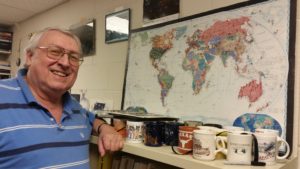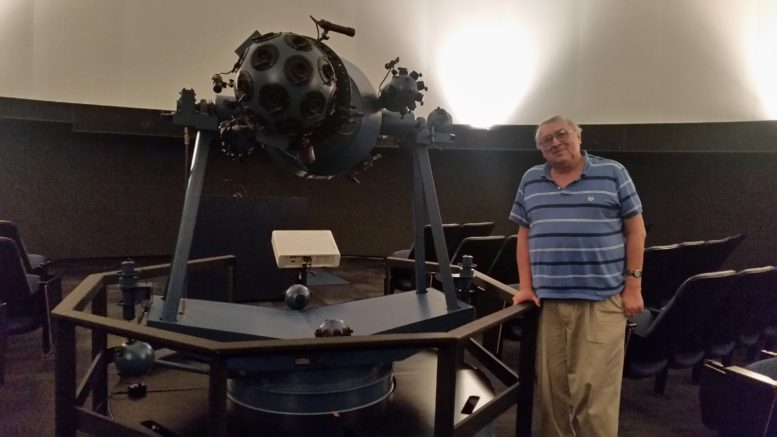By JAN LARSON McLAUGHLIN
BG Independent News
As the stars filled the domed sky and the cardboard rocket took off into space, one of the students quietly slid over to sit in her teacher’s lap.
“This was so real, one little girl thought the dome took off,” teacher Nancy Frankart said after the planetarium show was over and the lights came on. “She thought we were traveling to space.”
That is music to Dale Smith’s ears.
Smith has been director at the Bowling Green State University Planetarium since it opened in 1983.
“I came with it. That makes me the best director they’ve ever had and the worst director they’ve ever had,” he said, smiling.
Smith started focusing on the stars as a child in upstate New York. “In third grade, a friend lent me a book about planets, and I was hooked,” he said. “A lot of astronomers have similar stories. Something grabbed ahold of us.”
For some, like Smith, it’s not enough to look skyward themselves. They want others to enjoy the view as well.
“Something inspired us and we want to share our love of the universe with audiences.”
And that’s exactly what Smith does as he turns off the lights, asks the children to put on their imaginary seatbelts, lean back in the planetarium chairs and travel through space.
Last week, he took first through third graders from St. Wendelin Catholic School in Fostoria on a ride in the “Secret of the Cardboard Rocket.” This particular show tells of siblings who build a spaceship out of cardboard and spend the night in it in their backyard. The rocket blasts off in the night, taking the pair to every planet in this solar system.
The students’ eyes were glued to the dome ceiling for the 40-minute trip to Pluto and back. The shows get routine for Smith, but the children’s questions after the show continue to thrill him.
“Once the first one asks, the ice is broken,” Smith said. And the flood of questions began. “You never know what you are going to get.” Last week was no different, when the lights came on, the little hands shot up.
- How do the gas giant planets stay together?
- Are all the planets real?
- Why don’t all planets have gravity?
- Why is Uranus on its side, was it knocked over?
- Are ice crystals worth money?
Smith answers them all. It would take nine years to travel to Pluto and back. A person weighing 100 pounds on earth would weigh 40 pounds on Mars. Yes, you would boil to death on Venus – right away. Astronauts can rest on spaceships because it’s not like driving a car. Once they blast off, it’s “sort of on autopilot.”
Then comes the question specifically aimed at Smith. “How do you know all this?”
Ahhhh, that allows Smith to share his other loves – books and imagination. Smith explains that he does his homework and reads lots of books. Then, like the siblings in the cardboard rocket, he opens his mind.
“They used their imaginations,” he said. “With your imaginations, you can go anywhere.”
Smith sends the students home with instructions to continue looking up into space, specifically where they can find Jupiter right now in the night sky. And, he adds a pitch for the children to bring their parents to the planetarium.

Dale Smith shows world map in his office covered with pins on the 60-plus countries he has visited.
Smith has shows for all ages at the planetarium with its 40-foot dome. For the youngest, he shows “Larry Cat in Space,” and hands out some glow-in-the-dark teddy bears.
“If the 5-year-olds see the stars and have a good time, I’m content,” he said. “I hope they go away thinking science is fun.”
For older viewers, Smith hopes the planetarium creates some of those rare “aha” moments in science. And he doesn’t want those moments to end when the lights come back on.
“You can just step out in your backyard,” he said. “I want people to go out and connect with the sky.”
If possible, it can start a lifelong love of astronomy. “When they are 70, they will take their grandkids out.”
Smith realizes many people access the solar system on their computer screens. But that solitary experience just isn’t the same as sitting in a planetarium.
“We’ve got the dome you don’t have at home,” he said. It’s almost like a social experience at the movie theater.
People like to share out-of-this-world experiences with others, Smith said, recalling 2003 when Mars was shining especially bright. The line of people wanting to view Mars from the BGSU observatory stretched out to the street. People waited two hours to share that experience with others, he said.
Smith has seen the stars with his feet planted all over the world. In his travels to more than 60 countries, including the North Pole and edge of Antarctica, he has seen for himself that the sky changes greatly depending on his vantage point.
Traveling east or west, the sky stays the same. So people in Tokyo, Madrid and Afghanistan are seeing the same sky as Ohioans, and as the Egyptians building the pyramids, Smith said.
But from the north and south, the sky differs greatly. Smith has been to Australia 11 times, the first of which he slept out in a car with a sky chart and flashlight.
“We have the Big Dipper, they have the Southern Cross,” he said.
In Smith’s office, pins cover all areas of a world map. But he’s not done yet. “One of my goals is to make the South Pole.” Wherever, he goes, Smith will be looking at far more than the earth terrain. He will be checking out the sky that he learned to love years ago.

